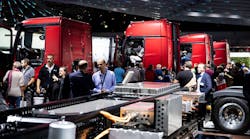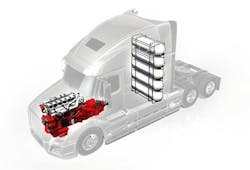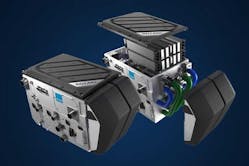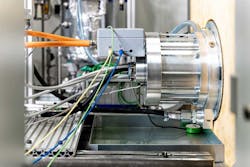What you'll learn:
- The hot topics at IAA Transportation 2022.
- Latest innovations in the hydrogen ICE and hydrogen fuel-cell spaces.
- The trend toward building 48-V systems.
IAA Transportation 2022, kicking off today in Hannover, Germany and running through September 25, is the world's largest platform for transport and logistics. It’s restarting after the break caused by the pandemic, and arrives with a new concept: Formerly known as IAA Commercial Vehicles, which focused on light and heavy commercial vehicles, the show now covers the entire transport and logistics spectrum.
Commercial vehicle suppliers are acutely aware that emission standards are tightening worldwide. The European Union and the U.S. have initiated regulatory processes to update heavy-duty vehicle emission standards.
First introduced in 1992, the Euro emissions standards are strict regulations that are designed to limit exhaust emissions and protect the health of the general public. The next stage of emissions standards, Euro VII, is targeted for introduction in 2026-27. To ensure vehicles on EU roads are clean over their lifetime, the proposed rules will consider new vehicle technologies and ensure emissions are measured in real-time.
In the U.S., the California Air Resources Board (CARB) and the U.S. Environmental Protection Agency (EPA) are introducing more stringent regulations in 2024 and 2027, respectively. Emission limits are expected to drive the adoption of technologies that simultaneously reduce nitrous oxides (NOx) and CO2. Collectively, these new regulations will reduce tailpipe NOx limits by up to 90%and CO2 by up to 30%.
Hydrogen ICEs
Emission regulations could motivate OEMs to actively support the deployment of hydrogen-based internal combustion engines (ICEs). In addition to the fuel cell, the use of hydrogen as a combustion fuel has the potential to make many heavy-duty and off-highway applications climate-neutral particularly quickly. Hydrogen engines are ideal for high load cycles with sudden load steps, and they handle heat, contamination, and vibration well.
Jim Nebergall, General Manager of the Hydrogen Engine Business at Cummins, points out that when people think about hydrogen for commercial vehicle use, they often think of fuel cells. Battery electric ICEs, however, also are a viable way to power a vehicle with hydrogen. Hydrogen ICEs can achieve the same outcomes as fuel cells in terms of reducing greenhouse gas emissions, but with a smaller upfront investment.
With an ICE, hydrogen vehicles could cost less than fuel-cell vehicles. They may also be less expensive than a battery electric vehicle (BEV) of similar size with an equivalent range. That’s because they’re almost entirely identical in design and construction to regular gasoline and diesel vehicles. They can be mass-produced using the same supply chains and the same factories.
Hydrogen Fuel Cells
Heavy commercial electric vehicles will quickly drain battery packs—the longer the journey and heavier the vehicle, the more a battery-based electric drive reaches its limits. That’s where the strengths of the fuel cell come into play. Bosch, for example, has equipped two vans with this technology and started test operation on the road.
“The fuel cell enables long ranges and short refueling times, which makes long journeys more economical,” says Dr. Markus Heyn, member of the Bosch board of management and chairman of the Mobility Solutions business sector. The partner in the project is ABT eLine GmbH, which designed and converted the vehicles together with Bosch Engineering GmbH. At IAA Transportation, Bosch will offer interested visitors the opportunity to experience the test vehicles and its fuel-cell technology in action on a track.
The developers were able to use Bosch components almost throughout for the fuel-cell system. A fuel-cell kit is used, which comprises the stack, anode supply module including hydrogen gas injector and recirculation blower, electronic control unit (ECU), electric air compressor and components for the hydrogen storage system, and numerous sensors. The batteries, including peripherals, were replaced by the fuel cell and five storage tanks for a total of over 22 pounds of hydrogen, plus a smaller lithium-ion battery.
“Accommodating the fuel-cell components in the available installation space was a major challenge,” says Dr. Uwe Gackstatter, president of the Bosch Powertrain Solutions division. The company’s partner, ABT eLine, adapted the cooling system, the vehicle control system, and the electrical system. Bosch designed the fuel-cell system, integrated it into the vehicle together with the hydrogen storage system, and developed the associated control system. After the required technical tests, the vehicles were granted official approval for road use.
Loaded, the vehicles can travel up to 335 miles and are fully refueled again in six minutes. The fuel cell can therefore be a good addition to the battery-electric drive in future vehicles for fleet operators whose vans cover particularly long distances during the day and return to the maintenance and storage facility in the evening.
At the company’s IAA Transportation 2022 exhibit, Ballard will showcase its 100-kW FCmove-HD+ fuel-cell module for mid-sized commercial vehicles. Ballard’s partner Quantron will unveil a new 44-ton truck integrating Ballard’s FCmove-XD concept engine for heavy-duty trucks.
Ballard and MAHLE joined forces to develop a new fuel-cell engine platform for the requirements of the 19-ton and above segment, offering power outputs ranging up to 360 kW. Says Randy MacEwen, CEO, Ballard Power Systems, “Our collaborations with automotive leaders such as MAHLE and Quantron, as well as strategic partners including Forsee Power, Weichai, and Linamar, accelerate our entry into the truck market and aims to have hydrogen-powered zero-emission trucks on the road in the next 18 months.”
Quantron’s truck will be available from the second half of 2023 onwards and offers a range of up to 700 km, hydrogen storage capacity exceeding 50 kg, and battery capacity of 120 kWh.
Faurecia and HELLA will appear together for the first time at this year's show under their umbrella brand FORVIA. On the FORVIA demo truck, the fuel-cell powertrain includes a complete hydrogen storage system with 80 kg of gaseous hydrogen stored and Symbio’s (a jointly owned Faurecia Michelin hydrogen company) 150-kW fuel-cell stack.
Leveraging the higher energy density of liquid hydrogen, Faurecia developed a compact storage solution that can store the same quantity of hydrogen with a volume reduced by 40%, thus enabling easier vehicle integration and maximizing the quantity of hydrogen on-board. This system is said to be particularly well-suited to intensive usage and will enable a greater range of autonomy, reaching the 1,000-km milestone. The cooled liquid-hydrogen storage system was co-developed with Air Liquide.
48-V Systems
Many vehicle systems today are powered directly from mechanical power generated by the engine, which runs 12-V systems such as air conditioning and pumps. Eaton is developing 48-V systems that include motor generators and inverters that generate 48-V dc power for the vehicle.
Eaton also produces 48-V dc-dc converters that step power down from 48-V vehicle architectures to power 12- and 24-V systems. Unlike competitive offerings, Eaton's dc-dc converters are operational in ambient temperatures up to 85°C and boast 97% design efficiency, according to the company.
“This development comes as global vehicle manufacturers are making decisions to adopt new technologies to meet emissions regulations,” says Ben Karrer, manager, Technology Development, Eaton’s Vehicle Group. “Of the options available, 48-V architectures are becoming more popular because they can decrease both CO2 and NOx simultaneously, which helps both our customers and the environment.”
Many of today’s vehicle systems, including the air-conditioning compressor, cooling fan, power-steering pump, and alternator, are powered by a front-end accessory drive on the engine. Electrical power is generated by an alternator producing 12 or 24 V. As the demand for more electrical power increases, commercial vehicles need to generate 48 V of power.
“48-V power will also be used to power systems such as HVAC and the engine cooling fan, which are traditionally run by the engine,” says Karrer. Electrifying the cooling fan provides additional benefits, as it could be reduced in size and strategically placed within the engine bay, allowing for aerodynamic design flexibility to increase fuel economy and reduce emissions.
MAHLE has identified an opportunity to supply electric motors for commercial vehicles, which places a premium on the ability to provide continuous high power. MAHLE’s new Superior Continuous Torque (SCT) electric motor is said to provide extremely high continuous power and thus is particularly suited to commercial vehicles.
Typically, electric motors provide their peak power for a short time and then drop to around 60% to 70% due to heat build-up. The new MAHLE SCT electric motor solves a dilemma common to many electric motors: the discrepancy between continuous and peak power.
While electric motors generally can only provide their peak power for a short time, the MAHLE SCT electric motor can be operated continuously at over 90% of its peak power. This means it can run indefinitely at high power and is significantly smaller and lighter than a conventional electric motor with the same continuous power. This suits it for use in all vehicle classes, including heavy commercial vehicles.
The new MAHLE design eschews magnets, instead using powered coils in its rotor. Unlike previous efforts, it transfers power to the spinning rotor via contactless induction to induce precisely tuned electromagnetic fields in rotor’s coils. As a result, there are basically no wear surfaces. The new motor will be presented for the first time at IAA Transportation.
ZF is unveiling its new CeTrax 2 electric central drive—an integrated, modular e-drive system for heavy-duty commercial vehicles. Leveraging in-house developed components, it features two oil-cooled e-motors as well as two integrated 800-V silicon-carbide (SiC) inverters. CeTrax 2 uses a three-speed gearbox that can perform power shifts.
With all components integrated within a compact single unit, CeTrax 2 allows manufacturers to offer both conventional ICE and electric drivelines on the same vehicle platform. In addition to enabling the quicker electrification of existing vehicle platforms, it enables high power and torque, lightweight design (approx. 385 kg) and e-drive efficiency of up to 96%, according to the company.
With continuous power of 360 kW and peak torque of 24,700 Nm for vehicles up to 44 tons, CeTrax 2’s electric central drive executes smooth gear changes due to seamless power shifting. Building on ZF’s decades of transmission and electrification experience, the gear changes are calculated by the integrated ECU and automatically executed by e-actuators. Series production of CeTrax 2 is set to commence with a major (unnamed) global truck manufacturer in 2023.
The new MAN eTruck, which the company will be showing for the first time in Hannover as a near-series prototype ahead of a 2024 launch, will not only electrify long-distance transport, but will cover all common transport segments handled by diesel trucks today. Its production with conventional trucks on a series production line makes the switch from diesel to electric particularly flexible.
A special technical feature is its preparation for future megawatt charging. High charging capacities with short charging times equip the electric truck for heavy-duty long-distance transport with daily ranges of between 600 and 800 km, and eventually even up to 1,000 km.



